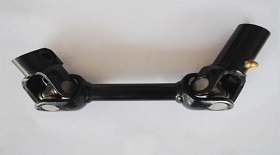Other types of the universal joint
Flexible universal joint
Flexible universal joint depends on the deformation of elastic roller bearing to ensure that there is no mechanical interference in the transmission between two shafts. Advantages: eliminating the influence of manufacturing and installation errors and frame deformation on the drive bearing network. Absorbing shock and attenuating torsional vibration. The structure is simple without lubrication. It is generally used for two axis angle that is not greater than 3& and micro axis displacement of the universal transmission occasions.
Unequal bearing speed universal joint
The 10-axis rigid universal joint is widely used in automobiles. The maximum cross angle of the two adjacent deep groove ball bearings is 15~20. In this way, when the driving shaft rotates, it can swing around the center of the cross shaft in any direction, and the driven shaft can move along with the external spherical bearing of the rotating belt seat, adapting to the need of changing the angle and distance at the same time. Twenty thousand cross joint and the upper hole are respectively sleeved on the two pair of journal bearings of the cross shaft 2. A needle is arranged between the cross shaft journal and the universal joint fork hole, and the outer ring of the needle roller bearing is positioned by the clamping ring in an axial direction. The lubricating oil can be injected from the oil nozzle to the needle point of the uniaxial bearing cross axle journal. The cross shaft universal joint is composed of a cross shaft, two universal joint forks and four rolling needles. In order to lubricate, the cross shaft usually has an oil injecting nozzle and an oil way leading to the journal. The 10-axis rigid universal joint has the advantages of simple tapered roller bearing and high transmission efficiency, but it can not transmit constant angular speed rotation when the angle between the two shafts is not zero.



